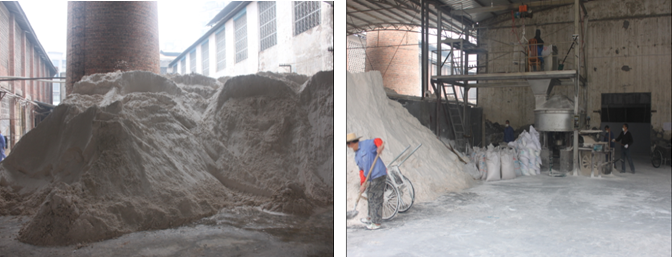Main raw materials of glass bottles introduction and usage
2015-03-23

Glass bottles are manufactured by more than a dozen raw materials like quartz powder, limestone, sodium carbonate, dolomite, feldspar, boric acid, sodium sulfate, barium sulfate, zinc oxide, potassium carbonate and cullet. Glass bottle is a container which will through 1600-degree heat to melt and shaping. Glass bottle can be produced in different shapes depending on different mold. Since hot forming, it is non-toxic and tasteless and it is main container of food, medicine drug and chemical industry. Here are introduction of some main raw material of glass bottles:
1. Quartz powder: It is a hard, wear-resistant, chemical stability of minerals, the main mineral component is quartz, main chemical ingredient is SiO2. Quartz powder is milk white or colorless translucent, hardness is 7, brittle, no cleavage, conchoidal fracture, oil sheen, density of 2.65, doesn’t dissolve in acid. Main usages: filter material, high grade glass, glass product, refractory, smelting stone, precision casting, sand blasting, grinding wheels materials, etc.
2. Limestone: Calcium carbonate is the main component of limestone. Limestone is the main raw material of glass. Lime and limestone mass used as building materials, they are important raw material in many industries. Calcium carbonate can be directly processed into stone and fired into quicklime.
3. Sodium carbonate: It is one of the important chemical raw materials, widely used in light industry, building materials, chemical industry, food industry, metallurgy, textiles, petroleum, national defense, medicine, etc. It is used as the raw materials, cleaning agents, detergents in the manufacturing of other chemicals, but also the field of photography and analysis.
4. Dolomite: It can be used as reformer refractory inner layer in steelmaking, slagging constituent, raw material of cement, fusing agent of glass, ceramic, fertilizer, building and decorative stone, paint, pesticide, medical, etc. It can be used in building material, ceramic, glass and refractory material, chemical industry and agriculture, environmental protection, energy saving fields.
5. Feldspar: one common aluminosilicate rock-forming mineral which contains calcium, sodium and potassium. There are 60% of feldspar in the crust, it occur in igneous, metamorphic, sedimentary rocks. Main usages: the manufacture of ceramic and porcelain enamel, raw materials of glass, abrasive, etc. It also can be used to produce potash fertilizer.
6. Boric acid: Soluble in water, alcohol, glycerin, ether and essential oil. Aqueous solution presents weak acid. Mass used in glass (optical glass, acid-resistant glass, heat-resistant glass, glass fiber used in insulation) industry, boric acid can improve glass products’ heat-resistant, transparent performance, and mechanical strength, it also can shorten the melt time.
7. Sodium sulfate: The main composed of sodium sulfate is Na2SO4 that a raw material imports from Na2O. Mainly used to remove SiO2 scum, play the role of a clarifying agent
8. Barium sulfate: Odorless, tasteless and colorless orthorhombic crystals or a white amorphous powder, property stable, insoluble in water, acids, alkali or organic solvents. It can be used as raw material or filler of paint, ink, plastics, rubber and battery materials in industry. In glass products it used as a clarifying agent, can play the role of anti-foaming and increasing gloss. It also used in ceramics, enamel, spices and pigments industries. It is the raw material for producing other barium salts.
9. Zinc oxide: Zinc oxide ZnO can increase chemical stability of sodium - calcium silicon glass and reduce its tendency to crystallize.
10. Potassium carbonate: Used in glass, printing and dyeing, soap, enamel, preparing sylvite, synthesis ammonia decarbonylation, color TV industry, in food as a leavening agent, adsorbents for gas, powder extinguishing agent, rubber antioxidant, etc.
11. Cullet: Most manufacturing process using 20% -30% of the cullet to facilitate melting and optimum mixing with quartz sand, feldspar and alkali, but also can improve the utilization of recycled glass, for saving energy and enhance environmental protection.































